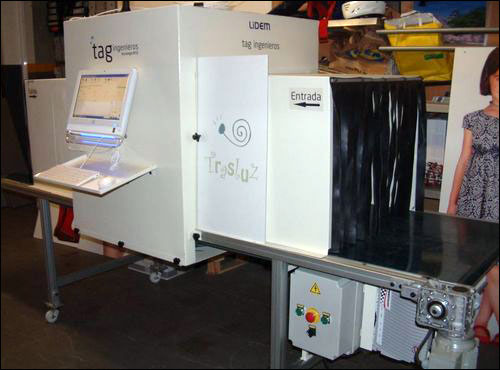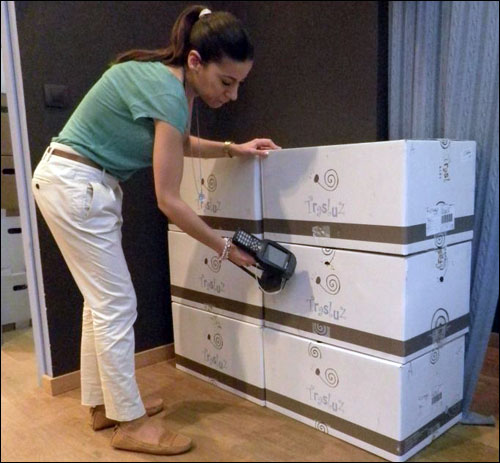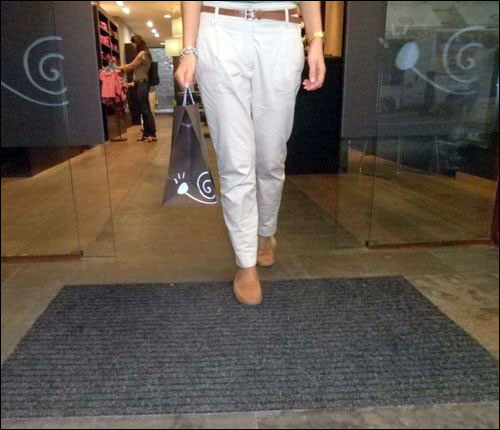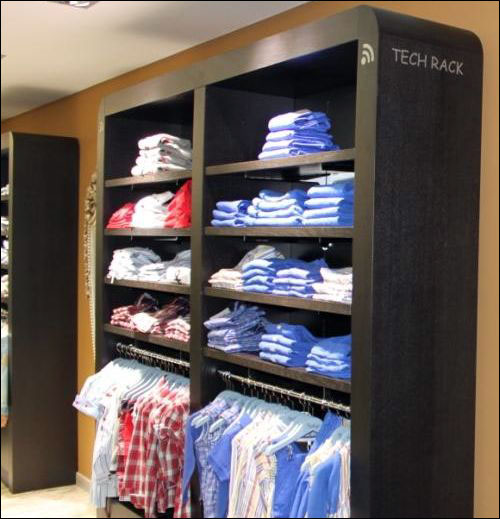Spanish clothing company Trasluz Casual Wear, which designs and sells apparel and accessories for children ages six months to 16 years, has launched 30 franchise stores over the past two years, each employing an RFID-based system that tracks every item from the point of manufacture to the stores, and on through the point of sale (POS). Trasluz has 30 franchised stores fully equipped with this technology, the firm reports. In addition, one store is equipped with smart shelves to read and supply inventory data in real time, while six others have RFID floor mats installed at their exit, for the purpose of security. As more franchise stores open, they, too, will implement the system, including smart shelves and RFID floor mats at doorways.
The solution is being provided by RFID systems integrator Tag Ingenieros Consultores, using its own software, readers supplied by Keonn Tech and UPM RFID passive EPC Gen 2 Web tags made with NXP Semiconductors‘ G2iL chips. This factory-to-warehouse-to-store system has made it possible for Trasluz to completely eliminate the need for workers to scan bar codes, and has also enabled the clothing firm to instead use RFID to track the inventory of goods within its warehouse and at its franchisees’ stores, as well as sales.

Trasluz Casual Wear has been in operation since 1999, selling its products through multi-brand stores. In 2009, however, the company opted to launch franchise stores—initially throughout Spain, and eventually worldwide. The company designs original styles that it now sells online on its Web site, as well as at multi-brand stores and its franchise stores. To help manage the growth that it expected from the addition of the franchise stores, the company sought a technological solution to provide visibility into product inventory on a central database.
“Trasluz chose RFID technology because it improves the customer shopping experience, as well as Trasluz processes at stores and across the supply chain,” says Javier Martínez Zaldo, the company’s manager and administrator. The goal, he reports, was to use RFID to provide product visibility at its factory, warehouse and stores, and to expedite the reordering and shipping of products to stores.The Tag Ingenieros RFID-based system, known as the Retail Management System, comes with middleware to manage transmission data, as well as a centralized software application that resides on Trasluz’s back-end system to capture and store data resulting from each RFID tag read. From Trasluz’s headquarters, management can access every store’s POS transactions by logging into the central server, and thereby know which products are selling, and at which locations.
When the garments and accessories are manufactured, either in Spain or in other countries, factory employees attach an RFID tag to each item’s label, and then verify the read using a handheld interrogator. That data is stored on the central server, linking the tag ID with that item’s stock-keeping unit (SKU). The items are then loaded into boxes and sent to the central warehouse in Spain, where workers who receive the goods place the boxes on a conveyor belt with a built-in Intermec RFID reader and antennas, in order to read the unique ID number on each item’s tag. In that way, all goods within the boxes can be identified instantly, and without opening each box. Once shipped to the stores, the products again pass along the conveyor, and the system software is updated to indicate that specific products have been shipped to a particular retailer.
When items are received by a store, workers utilize a Nordic ID handheld device to read each tag, even before unpacking the boxes. The reader forwards this data to the back-end system, via a Wi-Fi connection, and the software then compares the tag ID numbers of the items received, updating the records to indicate which products have arrived. Staff members then use the handheld readers to undertake inventory checks on the sales floor, or in the back rooms, thereby confirming what is in stock and identifying when something needs to be reordered.
Upon choosing a product for purchase, a customer takes that item to a checkout counter, where an Intermec desktop reader interrogates all of the RFID tags’ IDs and sends those numbers to the POS software, where the goods are rung up and marked as sold in the inventory records. If inventory gets too low as a result of those sales, re-ordering can also be prompted. Finally, when leaving the store, the individual walks over an RFID reader antenna built into a floor mat (assuming that person was visiting one of the six stores in which the RFID mats have been installed). The antenna interrogates any RFID tags, and the system compares the tag IDs with the sales inventory status, in order to determine whether the products have been purchased. If a tag is read for any item that is unsold, an alert can be issued to initiate either the sounding of an alarm at the door, or a message to store management that an unsold item is being removed.The floor mat with embedded antennas was jointly developed by Tag Ingenieros and Keonn, to provide an RFID reader that would not cause an aesthetic problem. The embedded antennas were positioned in such a way as to read tagged items passing over the mat, but minimizing the risk of reading items located nearby within the store.
In addition, Trasluz has begun deploying RFID-based smart shelves; this has taken place at one store so far, Martinez says. The AdvanShelf RFID readers and antennas, developed by Keonn, are installed by Tag Ingenieros to read the tags of all items stacked on the shelves. If a product is removed from the shelf and not returned, the software sends that information to the inventory-management software. In this way, the store can track its inventory without relying on staff members to conduct periodic inventory checks using handheld interrogators.

“With all these systems in place, Trasluz is not using bar codes anymore,” Iglesias states, making the company possibly the first, and only, retailer to entirely phase out bar-coding.
Tag Ingenieros software stores all RFID data, which it links to Trasluz’s IT system. “Reports and alerts can be configured, and top and middle managers are informed immediately of any problem,” says Javier Muñoz Giner, Tag Ingenieros’ CEO. The Retail Management System middleware, he explains, “controls and manages the RFID hardware, and sends the real-time RFID data to the Retail Management System’s centralized software application.” The software then assembles the RFID data, processes it and presents it to Trasluz’s stores and headquarters, in order to make appropriate decisions.Every Trasluz store averages 120 square meters (1,292 square feet) in size, and has 6,000 to 7,000 items in stock. With the RFID system, each store is able to employ only two or three employees (due to the reduction in time required for inventory checks with bar-coding). The labor needed to receive new goods is cut in half, Muñoz estimates, compared to that which would be needed to perform inventory counts without the RFID system. Shrinkage is also reduced, he says, because the company now has greater visibility into which goods should be at a particular store, as well as when they left the warehouse, arrived at the store and were sold. Because all of the stores began operation with the RFID system, however, Trasluz cannot directly compare a non-RFID system with the existing technology. While inventory checks would traditionally require many hours of labor, Martinez notes, it now takes an employee less than an hour to complete inventory counts for an entire store. Reordering is also fast, thereby reducing the likelihood of out-of-stocks.

By the end of this year, Trasluz plans to have more than 50 franchised stores, including some in Asia. Each new store will be RFID-enabled, the company reports, just like the first 30.
What’s more, Trasluz expects to implement RFID smart shelves at other stores in addition to the existing deployment, as well as install the loss-prevention system based on RFID floor mats at all new stores, and introduce a customer loyalty program based on RFID cards, in order to provide a more personalized customer shopping experience.


